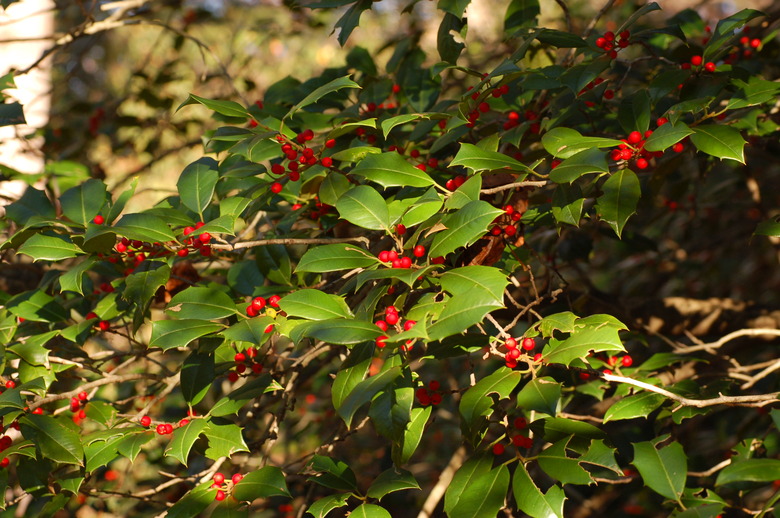How To Remove A Holly Bush
If your holly tree is self-seeding and you find multiple sharp seedlings under the tree or throughout your garden, you might be ready to say goodbye to that holly.
First, decide whether you are going to try to save the tree to transplant elsewhere or send it on its thorny way to tree heaven. If you're ready to rid of it, read on.
Warning
English holly (Ilex aquifolium) has naturalized in some areas of the U.S., including the Pacific Northwest, where it is listed on the invasive plant list. If your holly bush is of this variety, don't transplant it; discard it. If you have American holly (Ilex opaca) instead, the choice is yours, although North Carolina State University reports that American holly is a fire risk because it is highly flammable.
Holly (Ilex spp.), USDA plant hardiness zones 5 to 9, can grow quite large, although it is relatively slow growing. If your holly tree is 30 feet tall with a wide spread, you'll likely need professional help and equipment. If you are removing or transplanting a small holly shrub in the landscape, you have more options. Generally, the process includes removing all the branches and then dealing with the stump.
Take It Down to the Stump
When you are removing a holly rather than transplanting it, you can go straight for the jugular, with no need to try to save the root system.
Tip
If your tree or holly shrub is very large with an old, established root system, you may need to hire professionals rather than try a DIY on big tree removal. Professionals have the right equipment and machinery, and if they use herbicides, they will have the right permits.
If you do plan to DIY, gather your tools:
- Loppers or a handsaw
- Bow saw (chainsaw, optional)
- Shovel and trowel
- Mattock or hatchet
Remove the Branches
Grab some loppers or a handsaw and remove the branches, or at least as many of the branches as you can, so you can more easily access the trunk. Wear gloves! Those holly leaves mean serious business.
For branches larger than 1.5 inches thick, use a bow saw or a chainsaw (if you're handy with that tool). Your goal is to expose just the trunk so that you're not hampered by branches.
Warning
Wear protective gear, including long pants and heavy leather gloves. If you are using a chainsaw, wear chaps to protect your legs. Chaps jam the chain if you accidentally hit your leg.
Remove the Roots
Once you have only a trunk, you want to loosen and remove the roots to weaken the tree. Dig all around the trunk to expose the rootball and roots. Knock some of the soil from the roots with a trowel so you can easily see them.
Use a mattock or hatchet to sever the roots. Sometimes, rocking the trunk back and forth helps identify the remaining roots anchoring the trunk.
You want to get all the primary roots so that the holly doesn't regrow.
Remove or Treat the Stump
At this point, you have two options: Either dig out the holly tree stump (if it is not too large) or cut it down as close to the ground as possible and use chemicals to kill the tree stump over time.
Complete removal is much harder and faster because a tree stump treated with chemicals may take years to die and decompose.
Digging Out the Stump
There's really not much finesse or a specific set of instructions for digging out the tree stump. Once the roots have been removed, the stump should be sitting in its hole, waiting for a strong back. If the stump is too heavy to move, use your chainsaw to cut it into smaller sections.
Tip
If you don't plan to replant something in the same spot, consider renting a stump grinder. This tool slowly chips away at the stump to the depth of your choice, usually about 6 to 8 inches below the surface.
Treating the Stump
If digging out a big stump doesn't appeal to you, use a stump-killer product. Holly bushes will continue to sprout from a stump if the stump is left untreated.
Be sure to treat the stump immediately after cutting down the holly, because old stumps do not absorb the chemicals. If you have waited, recut the stump to get to fresh wood before applying.
Warning
When purchasing an herbicide designed to kill stumps, consult with your local university extension office to identify a product that is recommended in the home landscape. Some states have banned certain chemicals, so be sure to know the local regulations.
To ensure penetration, drill holes in the top of the stump and along the edge to expose the cambium under the bark. Paint the herbicide all over the exposed area. If suckers appear over time, apply herbicide to those as well.
You may need to reapply the chemical several times, and it may take years before the stump dies.
